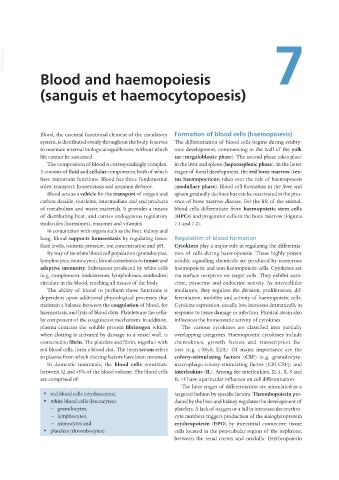Page 152 - Veterinary Histology of Domestic Mammals and Birds, 5th Edition
P. 152
VetBooks.ir 7
Blood and haemopoiesis
(sanguis et haemocytopoesis)
Blood, the essential functional element of the circulatory Formation of blood cells (haemopoiesis)
system, is distributed evenly throughout the body. It serves The differentiation of blood cells begins during embry-
to maintain internal biological equilibrium, without which onic development, commencing in the wall of the yolk
life cannot be sustained. sac (megaloblastic phase). The second phase takes place
The composition of blood is correspondingly complex. in the liver and spleen (hepatosplenic phase). In the latter
It consists of fluid and cellular components, both of which stages of foetal development, the red bone marrow (tex-
have important functions. Blood has three fundamental tus haemopoeticus) takes over the role of haemopoiesis
roles: transport, homeostasis and immune defence. (medullary phase). Blood cell formation in the liver and
Blood acts as a vehicle for the transport of oxygen and spleen gradually declines but can be reactivated in the pres-
carbon dioxide, nutrients, intermediate and end products ence of bone marrow disease. For the life of the animal,
of metabolism and waste materials. It provides a means blood cells differentiate from haemopoietic stem cells
of distributing heat, and carries endogenous regulatory (HPCs) and progenitor cells in the bone marrow (Figures
molecules (hormones), enzymes and vitamins. 7.1 and 7.2).
In conjunction with organs such as the liver, kidney and
lung, blood supports homeostasis by regulating tissue Regulation of blood formation
fluid levels, osmotic pressure, ion concentration and pH. Cytokines play a major role in regulating the differentia-
By way of its white blood cell population (granulocytes, tion of cells during haemopoiesis. These highly potent
lymphocytes, monocytes), blood contributes to innate and soluble signalling chemicals are produced by numerous
adaptive immunity. Substances produced by white cells haemopoietic and non-haemopoietic cells. Cytokines act
(e.g. complement, leukotrienes, lymphokines, antibodies) via surface receptors on target cells. They exhibit auto-
circulate in the blood, reaching all tissues of the body. crine, paracrine and endocrine activity. As intercellular
The ability of blood to perform these functions is mediators, they regulate the division, proliferation, dif-
dependent upon additional physiological processes that ferentiation, mobility and activity of haemopoietic cells.
maintain a balance between the coagulation of blood, for Cytokine expression, usually low, increases dramatically in
haemostasis, and lysis of blood clots. Platelets are the cellu- response to tissue damage or infection. Physical strain also
lar component of the coagulation mechanism. In addition, influences the homeostatic activity of cytokines.
plasma contains the soluble protein fibrinogen which, The various cytokines are classified into partially
when clotting is activated by damage to a vessel wall, is overlapping categories. Haemopoietic cytokines include
converted to fibrin. The platelets and fibrin, together with chemokines, growth factors and transcription fac-
red blood cells, form a blood clot. The term serum refers tors (e.g. c-Myb, E2A). Of major importance are the
to plasma from which clotting factors have been removed. colony-stimulating factors (CSF) (e.g. granulocyte-
In domestic mammals, the blood cells constitute macrophage-colony-stimulating factor [GM-CSF]) and
between 32 and 45% of the blood volume. The blood cells interleukins (IL). Among the interleukins, IL-3, IL-5 and
are comprised of: IL-15 have a particular influence on cell differentiation.
The later stages of differentiation are stimulated in a
· red blood cells (erythrocytes), targeted fashion by specific factors. Thrombopoietin pro-
· white blood cells (leucocytes): duced by the liver and kidney regulates the development of
− granulocytes, platelets. A lack of oxygen or a fall in intravascular erythro-
− lymphocytes, cyte numbers triggers production of the sialoglycoprotein
− monocytes and erythropoietin (EPO) by interstitial connective tissue
· platelets (thrombocytes). cells located in the peri-tubular region of the nephrons,
between the renal cortex and medulla. Erythropoietin
Vet Histology.indb 134 16/07/2019 14:58

